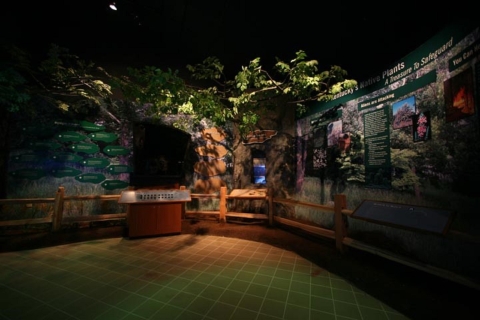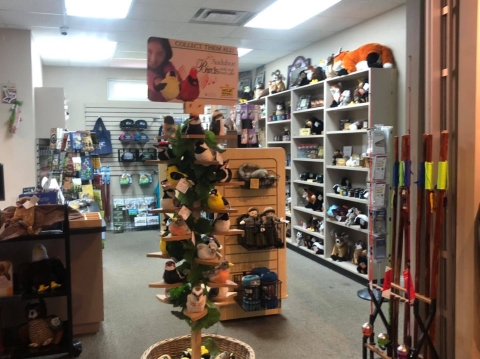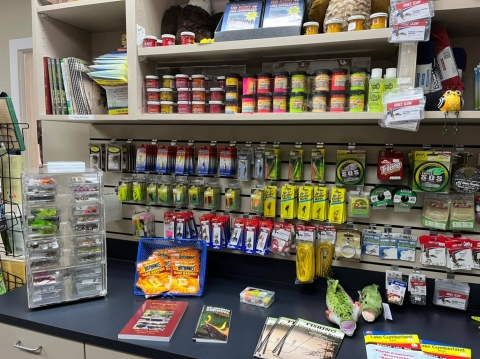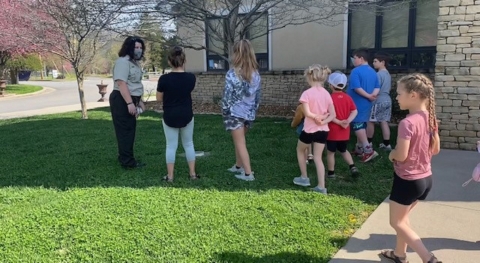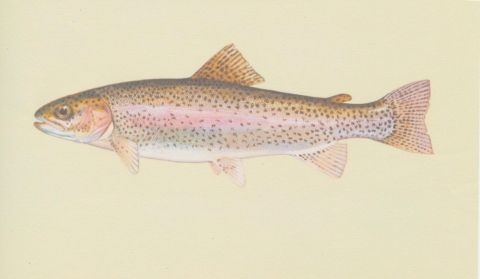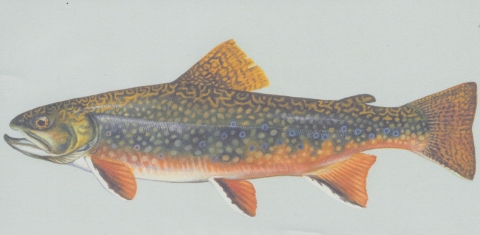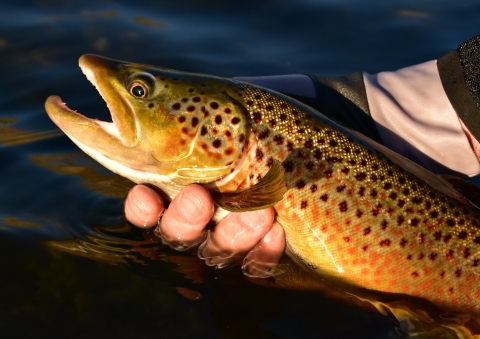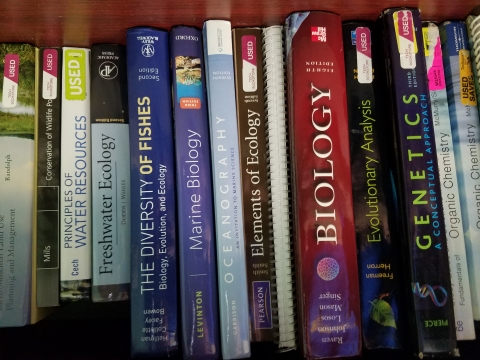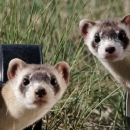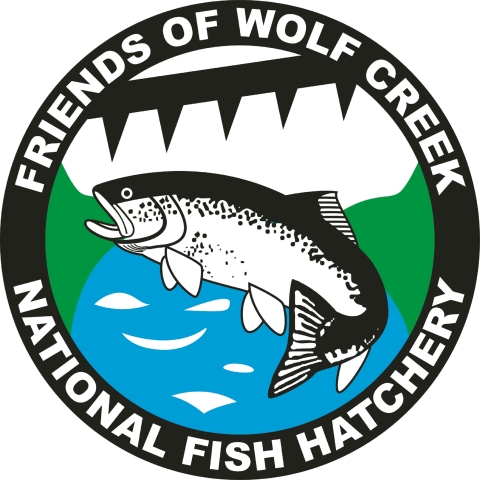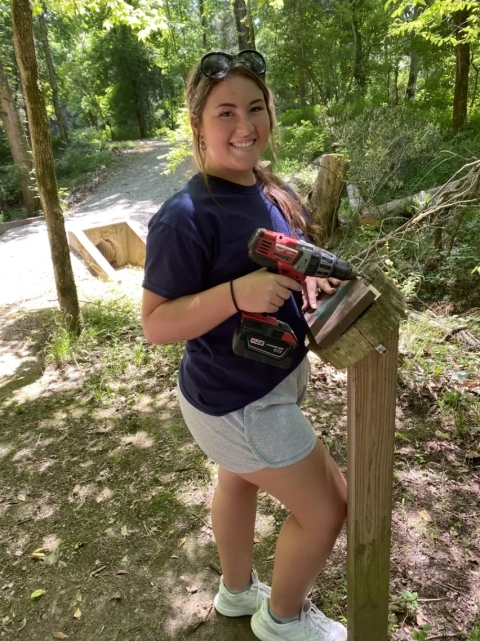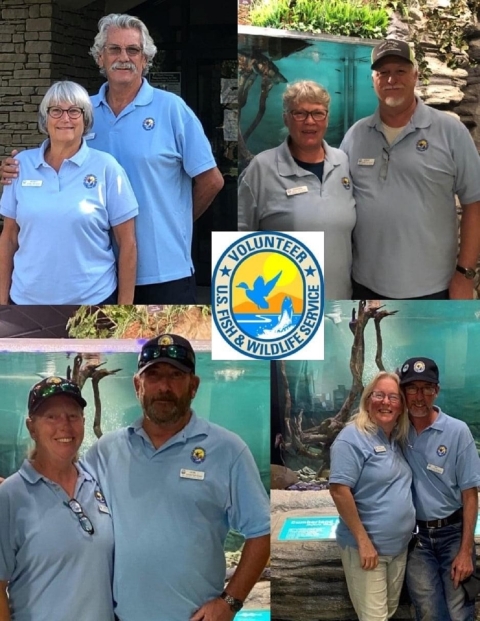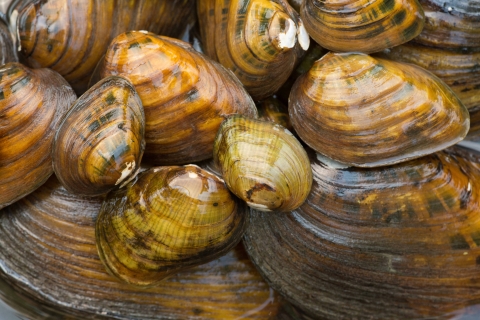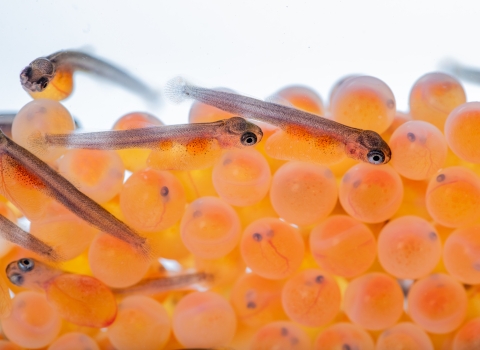An estimated 1,000,000 trout weighing 275,000 pounds are produced each year. These fish provide over $50 million dollars per year in direct economic benefits. These fish are stocked in coordination with the Kentucky Department of Fish and Wildlife Resources in over 125 public fishing waters within the commonwealth of Kentucky.
Visit Us
At Wolf Creek National Fish Hatchery, visitors can tour our interactive visitor/education center, learn about the trout life cycle in the hatchery building, feed fish in the outdoor raceways, take a walk through our Nature Trail, and spend some time fishing at Hatchery Creek.
Come face to face with the region’s underwater friends, explore karst terrain, see the inner workings of an active honey bee hive, and meet Dale, the lifelike animatronic fish biologist—all by stepping into the unique and exciting exhibit hall at the Wolf Creek National Fish Hatchery Visitor/Environmental Education Center. Much more awaits the entire family in a fun and engaging educational journey through the center—located on a working trout hatchery at the base of Wolf Creek Dam and beautiful Lake Cumberland. Visitors are welcome to tour the hatchery and fish the well-stocked creek below the hatchery. A theater, gift shop, picnic area, wheelchair accessible fishing ramp and special events make Wolf Creek National Fish Hatchery a destination not to be missed. Nearby camping at Kendall Campground is available.
Our gift shop is operated by the Friends of Wolf Creek National Fish Hatchery, Inc. The shop offers a wide array of books, pins, fishing bait and light tackle, home decorations and more - all designed with an outdoor/environmental education theme in mind. All proceeds from sales in the shop are used to help support the hatchery, its mission and environmental education and outreach needs.
Location and Contact Information
About Us
Since 1871, the National Fish Hatchery system has been at work improving recreational fishing and restoring aquatic species that are in decline, at risk, and are important to the health of our aquatic systems. Across the country, the network of National Fish Hatcheries work with states and tribes to conserve, restore and enhance the fish and aquatic resources of America for future generations.
Access the live Hatchery Creek cam: https://wcnfh.com/cam0.php
Access the live raceway webcam: https://wcnfh.com/cam1.php
Tours
The hatchery offers self-guided tours and pre-arranged group tours for children and adults. We provide tours to many school, church, and community groups throughout the year. Tours can be tailored to meet the educational needs and age level of the group. For example, if your group is interested in learning about fish production practices, the life cycle of trout, or about environmental issues in our community and world, just reach out to us and we will work with you to provide a fun, educational experience!
What We Do
Over a century ago, environmentalists recognized that conservation measures were necessary to maintain good fishing opportunities in our public waters. Fishing has always been one of America's leading forms of outdoor recreation. The primary responsibility of Wolf Creek National Fish Hatchery (NFH) is to raise rainbow, brook, and brown trout which will help preserve this tradition for present and future generations of Americans.
Access the interactive Stocking Map here: https://storymaps.arcgis.com/stories/0e88b596b2d74fb9b58d15cd351725e5
Our Species
Wolf Creek National Fish Hatchery is a cold water facility that produces trout. Approximately one million trout are produced each year. Species include rainbow, brook, and brown trout.
Our Library
Wolf Creek National Fish Hatchery's Library is a great place for you to dive deeper into what the U.S. Fish and Wildlife Service is about.
Get Involved
Friends and volunteers
Friends of Wolf Creek NFH, Inc.
Friends of Wolf Creek NFH, Inc. is a 501©(3) non-profit organization formed in 2005. The friends group provides a number of services for the community including:
- Plan, sponsor, and carry out four fishing events a year for children, seniors, and veterans;
- raise money to help the hatchery promote a better understanding and appreciation of the natural history, resources, and habitat of Kentucky;
- provide a scholarship to one Russell County High School senior wanting to major in fields of conservation of natural resources/environmental science in college; and
- sponsor several local students in the 4th-6th grades to attend conservation camp at Camp Earl Wallace.
The Friends of Wolf Creek NFH meets every 2nd Tuesday of the month at Wolf Creek National Fish Hatchery-1:00 p.m. CST. Contact Friends of Wolf Creek NFH to learn more or to become a member: friendsofwolfcreeknfh@gmail.com, or (270) 343-3797. Visit our Facebook page:https://www.facebook.com/fowcnfh.
Volunteer
Wolf Creek NFH relies heavily on volunteers to maintain facilities and provide services. Here, the contributions of volunteers are equivalent to nearly six additional full time employees per year.
There are many opportunities to volunteer with Wolf Creek NFH–whether that’s assisting in the Visitor Center or helping with fish production, volunteering during special events, or becoming a resident work camper.
Workcamping Program
We rely on work camping volunteers to staff and maintain our Center and assist in outreach activities year-round. Minimum three month commitment preferred.
In exchange for 20-27 hours/person/week (summer) and 18-24 hours/person/week (winter), volunteers receive a full hook-up campsite on a large, level, gravel lot, with fire pit and picnic table, onsite laundry, and limited WiFi. Propane provided during winter.
Work camping volunteer duties include: serving as point of contact for visitors–answering questions/providing assistance; leading tours and helping with field trips; caring for live education animals; performing day-to-day operation of Center gift shop; stocking brochures and handouts; cleaning Center including restrooms; performing minor maintenance; helping to plan special events, workshops and other outreach programs.
Contact
Projects and Research
Threatened and Endangered Species
Wolf Creek National Fish Hatchery is actively engaged in the recovery and restoration of imperiled aquatic species. Recovery and restoration activities include: on-station propagation; reintroductions; field surveys.
Currently, Wolf Creek National Fish Hatchery is working with the Barrens Topminnow species. We receive juvenile Barrens Topminnow from spawning facilities (Conservation Fisheries Inc., Tennessee Aquarium) and after grow-out, stock Barrens Topminnow into native streams in Tennessee.
Wolf Creek National Fish Hatchery is also engaged in the recovery and restoration of native freshwater mussels. The conservation of the freshwater mussels include species such as Cumberland Bean, Cumberland Combshell, Purple Cats Paw, Pink Mucket, Tan Riffleshell, Fluted Kidneyshell, Cracking Pearlymussel and Snuffbox.
Wolf Creek National Fish Hatchery raises rainbow, brook and brown trout to support recreational fisheries that have been impacted by federal dams. Over a century ago, environmentalists recognized that conservation measures were necessary to maintain good fishing opportunities in our public waters, the fish that Wolf Creek raises...


